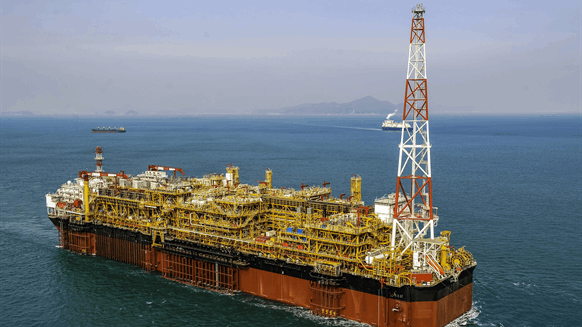Petrobras' Second FPSO in Mero Attains Top Production
by Rocky Teodoro|Rigzone Staff | Thursday, August 29, 2024 |
 The floating production storage and offloading (FPSO) vessel Sepetiba attained production of 180,000 barrels per day (bpd) of oil in the Mero field.
The floating production storage and offloading (FPSO) vessel Sepetiba attained production of 180,000 barrels per day (bpd) of oil in the Mero field.
Petróleo Brasileiro S.A. (Petrobras) reported that Sepetiba, a platform ship that it chartered, has reached top production.
The floating production storage and offloading (FPSO) vessel Sepetiba attained production of 180,000 barrels per day (bpd) of oil in the Mero field, in the Santos Basin’s pre-salt layer, Petrobras said in a news release. The milestone was reached within the estimated time frame of eight months due to the promptness of the unit’s oil treatment and gas compression systems, including the good productivity of the well in the Mero Basin, the company noted.
The undersea interconnection process also helped Sepetiba reach top production since 100 percent of the wells were interconnected in advance, around five months before contractual milestones. Petrobras said its technicians reduced the time of the activity by 18 percent, consequently speeding up the FPSO’s gradual increase in oil production.
The FPSO Sepetiba was chartered from SBM Offshore and became operational on December 31, 2023. The platform lies roughly 111.8 miles (180 kilometers) off the Rio de Janeiro coast, anchored at a depth of 2,000 meters. According to SBM, it has a storage capacity of 1.4 million barrels of oil.
The FPSO is fitted out with innovative technologies that aim to increase efficiency and decarbonize activities such as CCUS (carbon capture, utilization, and storage), where the carbon dioxide-rich gas is reinjected into the reservoir, driving down greenhouse gas emissions into the atmosphere, according to the release.
Petrobras said the Mero field now exceeds production of 410,000 bpd of oil. Mero is a unitized field, operated by Petrobras with a 38.6 percent interest, while TotalEnergies and Shell each hold 19.3 percent. The other partners are China National Petroleum Corp. and China National Offshore Oil Corp. with a 9.65 percent stake each, as well as PPSA (3.5 percent). Mero is the third largest field in Brazil in terms of volume of oil in place, behind only Tupi and Búzios, also located in the pre-salt Santos Basin.
In February, Petrobras announced that the FPSO Marechal Duque de Caxias, chartered from MISC, was headed for the Mero field in the pre-salt layer of the Santos Basin offshore Brazil.
The platform will start operating in September and has the capacity to produce up to 180,000 bpd of oil and compress up to 12 million cubic meters of gas per day, the company said in an earlier news release. The unit will be part of Mero’s third production system and includes the interconnection of 15 wells to the unit, eight oil producers, and seven water and gas injectors using underwater infrastructure.
The FPSO platform will be interconnected to HISEP equipment, which will separate the oil and gas at the bottom of the ocean, from where it will reinject the carbon dioxide-rich gas. HISEP is a technology patented by Petrobras that can potentially increase production and relieve the surface gas processing plant while reducing the intensity of greenhouse gas emissions.